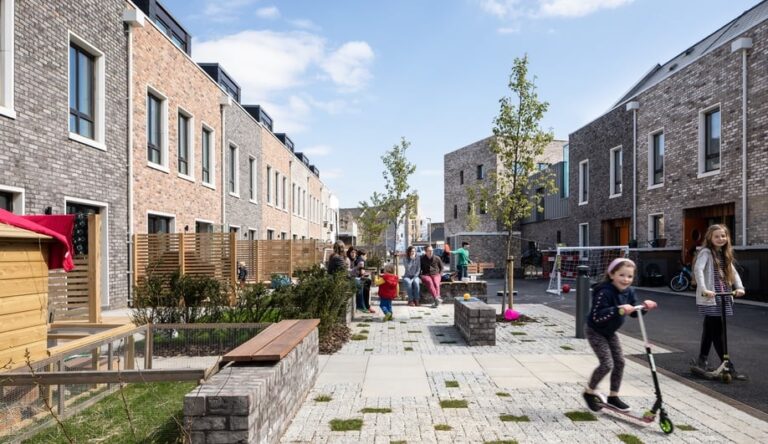Firstly, this is a really great bolg and also sustainable communities is one of the topics which interests to me. The blog highlights the fact that residential diversity and mixed-use development can increase the flexibility of a community for future uses, as Jacobs (1961) emphasised mixed-use development encourages vibrant, dynamic communities that meet the diverse needs of their residents. Moreover, being pedestrian friendly is a significant aspect of sustainable development that could reduce people’s dependence on vehicles to a large extent, for example, the Stroget pedestrian zone in Copenhagen or Barcelona’s Super Neighbourhoods, which provide evidence to further validate the argument of the blogs by showing material improvements in air quality, social interactions, and the local economy (Gehl, 2010; Rueda, 2018). Furthermore, the writers mention high density as one of the design guidelines for sustainable design. Indeed, it largely caters to the principles of contemporary urbanism, as Newman and Kenworthy (1999) claim that denser and more compact cities could reduce carbon footprints, conserve natural landscapes and improve urban efficiency. However, there are potential risks resulting from high density that cannot be ignored, including the risk of overcrowding, strained public services and the requirement for quality public space to ensure livability. Therefore, it is necessary to consider the design of high-density neighbourhoods by incorporating green ecosystems into the planning of high-density urban areas, as proposed by Yan, Li and Li et al. (2024) that the required balance of biodiversity, ecosystem services, and green infrastructure could be largely supported by enhancing ecological connectivity. Overall, through the practice of residential diversity, mixed-use development, pedestrian friendliness, high-density design, and the incorporation of green ecosystems into planning, it is an opportunity to create neighbourhoods that are both flexible and sustainable to respond to future requirements.
References
Gehl, J. (2010). Cities for people. Washington, Dc: Island Press.
Jacobs, J. (1961). The Death and Life of Great American Cities. New York: Random House.
Newman, P. and Kenworthy, J.R. (1999). Sustainability and cities: overcoming automobile dependence. Washington, D.C.: Island Press.
Rueda, S. (2018). “Superblocks for the design of new cities and renovation of existing ones: Barcelona’s case”. In M., Nieuwenhuijsen and H., Khreis (eds) Integrating human health into urban and transport planning-a framework. Online: Springer Cham, PP. 135-153. Available at: https://link.springer.com/chapter/10.1007/978-3-319-74983-9_8. (Accessed: 28 March 2024)
YAN, S., LI, X., LI, T. and ZHENG, X. (2024). “Exploration of Construction Measures and Paths for Urban Parks and Green Spaces Under the Background of Opening and Sharing”. Landscape Architecture, 31(2), pp.12–18. Available at: https://doi.org/10.3724/j.fjyl.202401020003. (Accessed: 28 March 2024)






Firstly, this is a really great bolg and also sustainable communities is one of the topics which interests to me. The blog highlights the fact that residential diversity and mixed-use development can increase the flexibility of a community for future uses, as Jacobs (1961) emphasised mixed-use development encourages vibrant, dynamic communities that meet the diverse needs of their residents. Moreover, being pedestrian friendly is a significant aspect of sustainable development that could reduce people’s dependence on vehicles to a large extent, for example, the Stroget pedestrian zone in Copenhagen or Barcelona’s Super Neighbourhoods, which provide evidence to further validate the argument of the blogs by showing material improvements in air quality, social interactions, and the local economy (Gehl, 2010; Rueda, 2018). Furthermore, the writers mention high density as one of the design guidelines for sustainable design. Indeed, it largely caters to the principles of contemporary urbanism, as Newman and Kenworthy (1999) claim that denser and more compact cities could reduce carbon footprints, conserve natural landscapes and improve urban efficiency. However, there are potential risks resulting from high density that cannot be ignored, including the risk of overcrowding, strained public services and the requirement for quality public space to ensure livability. Therefore, it is necessary to consider the design of high-density neighbourhoods by incorporating green ecosystems into the planning of high-density urban areas, as proposed by Yan, Li and Li et al. (2024) that the required balance of biodiversity, ecosystem services, and green infrastructure could be largely supported by enhancing ecological connectivity. Overall, through the practice of residential diversity, mixed-use development, pedestrian friendliness, high-density design, and the incorporation of green ecosystems into planning, it is an opportunity to create neighbourhoods that are both flexible and sustainable to respond to future requirements.
References
Gehl, J. (2010). Cities for people. Washington, Dc: Island Press.
Jacobs, J. (1961). The Death and Life of Great American Cities. New York: Random House.
Newman, P. and Kenworthy, J.R. (1999). Sustainability and cities: overcoming automobile dependence. Washington, D.C.: Island Press.
Rueda, S. (2018). “Superblocks for the design of new cities and renovation of existing ones: Barcelona’s case”. In M., Nieuwenhuijsen and H., Khreis (eds) Integrating human health into urban and transport planning-a framework. Online: Springer Cham, PP. 135-153. Available at: https://link.springer.com/chapter/10.1007/978-3-319-74983-9_8. (Accessed: 28 March 2024)
YAN, S., LI, X., LI, T. and ZHENG, X. (2024). “Exploration of Construction Measures and Paths for Urban Parks and Green Spaces Under the Background of Opening and Sharing”. Landscape Architecture, 31(2), pp.12–18. Available at: https://doi.org/10.3724/j.fjyl.202401020003. (Accessed: 28 March 2024)